Advancing the Diagnosis of Diabetic Neuropathies: Electrodiagnostic and Skin Autofluorescence Methods
Abstract
1. Introduction
2. Materials and Methods
Ethical Aspects of the Research
3. Results
3.1. Clinical Case 1
3.2. Clinical Case 2
3.3. Clinical Case 3
3.4. Clinical Case 4
3.5. Clinical Case 5
3.6. Clinical Case 6
3.7. Clinical Case 7
4. Discussion
4.1. Plexopathy versus Neuropathy
4.2. Carpal Tunnel Syndrome in Diabetes Mellitus
4.3. From Roots to Focal Neuropathies
4.4. Present and Future Interdisciplinary Perspectives and Skin Autofluorescence Considerations
5. Conclusions
Author Contributions
Funding
Institutional Review Board Statement
Informed Consent Statement
Data Availability Statement
Acknowledgments
Conflicts of Interest
References
- Lupescu, D.T. Electrodiagnosticul în neuropatia diabetică. In Neuropatia Diabetică; Editura Viața Medicală: Bucharest, Romania, 2016; pp. 40–43. [Google Scholar]
- Hermányi, P.; Kempler, P. Types, clinical picture, and diagnosis of somatic neuropathy. In Neuropathies. A Global Clinical Guide; Kempler, P., Varkonyi, T., Eds.; Zafir Press: Budapest, Hungary, 2012; Volume 3, pp. 35–46, 53–59. [Google Scholar]
- Preston, D.C.; Shapiro, D.E. Electromyography and Neuromuscular Disorders: Clinical–Electrophysiologic Correlations; Elsevier Inc.: Amsterdam, The Netherlands, 2013; Volume 6, pp. 271, 358, 390, 503, 507, 514–515, 622. [Google Scholar]
- Glenn, M.D.; Jabari, D. Diabetic Lumbosacral Radiculoplexus Neuropathy (Diabetic Amyotrophy). Neurol. Clin. 2020, 38, 553–564. [Google Scholar] [PubMed]
- Tracy, J.A.; Dyck, B.J. The Spectrum of Diabetic Neuropathies. Phys. Med. Rehabil. Clin. N. Am. 2008, 19, 1–26. [Google Scholar]
- Pop-Busui, R.; Boulton, A.J.; Feldman, E.L.; Bril, V.; Freeman, R.; Malik, R.A.; Sosenko, J.M.; Ziegler, D. Diabetic Neuropathy: A Position Statement by the American Diabetes Association. Diabetes Care 2017, 40, 136–154. [Google Scholar] [CrossRef]
- Jermendy, G.; Kempler, P. The clinical features and diagnosis of autonomic neuropathy. In Neuropathies. A Global Clinical Guide; Kempler, P., Varkonyi, T., Eds.; Zafir Press: Budapest, Hungary, 2012; Volume 4, pp. 69–95. [Google Scholar]
- Oprea, E.; Berteanu, M.; Cintezã, D.; Manolescu, B.N. The effect of the ALAnerv nutritional supplement on some oxidative stress markers in postacute stroke patients undergoing rehabilitation. Appl. Physiol. Nutr. Metab. 2013, 38, 613–620. [Google Scholar]
- Potcovaru, C.-G.; Salmen, T.; Bîgu, D.; Săndulescu, M.I.; Filip, P.V.; Diaconu, L.S.; Pop, C.; Ciobanu, I.; Cinteză, D.; Berteanu, M. Assessing the Effectiveness of Rehabilitation Interventions through the World Health Organization Disability Assessment Schedule 2.0 on Disability—A Systematic Review. J. Clin. Med. 2024, 13, 1252. [Google Scholar] [CrossRef] [PubMed]
- Poenaru, D.; Ojoga, F.; Sandulescu, M.; Cinteza, D. Conservative therapy in ulnar neuropathy at the elbow (Review). Exp. Ther. Med. 2022, 24, 517. [Google Scholar] [CrossRef]
- Nasui, B.A.; Talaba, P.; Nasui, G.A.; Sirbu, D.M.; Borda, I.M.; Pop, A.L.; Ciortea, V.M.; Irsay, L.; Purcar-Popescu, A.I.; Cinteza, D.; et al. The Influence of Diet and Physical Activity on Oxidative Stress in Romanian Females with Osteoarthritis. Nutrients 2022, 14, 4159. [Google Scholar] [CrossRef] [PubMed]
- Galiero, R.; Caturano, A.; Vetrano, E.; Beccia, D.; Brin, C.; Alfano, M.; Di Salvo, J.; Epifani, R.; Piacevole, A.; Tagliaferri, G.; et al. Peripheral Neuropathy in Diabetes Mellitus: Pathogenetic Mechanisms and Diagnostic Options. Int. J. Mol. Sci. 2023, 24, 3554. [Google Scholar] [CrossRef]
- Siao, P.; Kaku, M. A Clinician’s Approach to Peripheral Neuropathy. Semin. Neurol. 2019, 39, 519–530. [Google Scholar]
- Bembenek, J.P.; Sobańska, A.; Litwin, T. Consistency of the results of neurophysiological examinations with clinical diagnosis formed by the referring physician in ambulatory medical care. Postep. Psychiatr. Neurol. 2023, 32, 18–22. [Google Scholar]
- Weiss, L. Carpal tunnel syndrome. In Easy EMG; Weiss, L., Silver, J.K., Weiss, J., Eds.; Elsevier Inc.: Amsterdam, The Netherlands, 2004; pp. 121–125. [Google Scholar]
- Hernández-Secorún, M.; Montaña-Cortés, R.; Hidalgo-García, C.; Rodríguez-Sanz, J.; Corral-de-Toro, J.; Monti-Ballano, S.; Hamam-Alcober, S.; Tricás-Moreno, J.M.; Lucha-López, M.O. Effectiveness of Conservative Treatment According to Severity and Systemic Disease in Carpal Tunnel Syndrome: A Systematic Review. Int. J. Environ. Res. Public Health 2021, 18, 2365. [Google Scholar] [CrossRef]
- Mondelli, M.; Aretini, A.; Ginanneschi, F. Electrophysiological Study of the Tibial Nerve Across the Tarsal Tunnel in Distal Symmetric Diabetic Polyneuropathy. Am. J. Phys. Med. Rehabil. 2022, 101, 152–159. [Google Scholar] [PubMed]
- Singh, R.; Barden, A.; Mori, T.; Beilin, L. Advanced glycation end-products: A review. Diabetologia 2001, 44, 129–146. [Google Scholar]
- Mooldijk, S.S.; Lu, T.; Waqas, K.; Chen, J.; Vernooij, M.W.; Ikram, M.K.; Zillikens, M.C. Skin autofluorescence, reflecting accumulation of advanced glycation end products, and the risk of dementia in a population-based cohort. Sci. Rep. 2024, 14, 1256. [Google Scholar]
- Sugimoto, K.; Yasujima, M.; Yagihashi, S. Role of advanced glycation end products in diabetic neuropathy. Curr. Pharm. Des. 2008, 14, 953–961. [Google Scholar] [PubMed]
- Tomkins, M.; Lawless, S.; Martin-Grace, J.; Sherlock, M.; Thompson, C.J. Diagnosis and Management of Central Diabetes Insipidus in Adults. J. Clin. Endocrinol. Metab. 2022, 107, 2701–2715. [Google Scholar]
- Jujic, A.; Engström, G.; Nilsson, P.M.; Johansson, M. Accumulation of advanced glycation end products in skin and increased vascular ageing in the general population: The Malmö Offspring Study. J. Hypertens. 2024, 42, 530–537. [Google Scholar]
- Martínez-García, I.; Cavero-Redondo, I.; Álvarez-Bueno, C.; Pascual-Morena, C.; Gómez-Guijarro, M.D.; Saz-Lara, A. Non-invasive skin autofluorescence as a screening method for diabetic retinopathy. Diabetes Metab. Res. Rev. 2024, 40, e3721. [Google Scholar] [PubMed]
- Hosseini, M.S.; Razavi, Z.; Bahri, R.A.; Ehsani, A.H.; Firooz, A.; Aryanian, Z.; Ehsani, A.; Sadeghi, Y. Is skin autofluorescence a novel non-invasive marker in diabetes? A systematic review and meta-analysis of case-control studies. J. Res. Med. Sci. 2023, 28, 68. [Google Scholar]
- Stirban, A.; Heinemann, L. Skin Autofluorescence—A Non-invasive Measurement for Assessing Cardiovascular Risk and Risk of Diabetes. Eur. Endocrinol. 2014, 10, 106–110. [Google Scholar]
- Meerwaldt, R.; Graaff, R.; Oomen, P.H.N.; Links, T.P.; Jager, J.J.; Alderson, N.L.; Thorpe, S.R.; Baynes, J.W.; Gans, R.O.B.; Smit, A.J. Simple non-invasive assessment of advanced glycation endproduct accumulation. Diabetologia 2004, 47, 1324–1330. [Google Scholar] [PubMed]
- Reurean-Pintilei, D.; Pantea Stoian, A.; Salmen, T.; Stoica, R.-A.; Mititelu-Tartau, L.; Lazăr, S.; Timar, B. Associations between Skin Autofluorescence Levels with Cardiovascular Risk and Diabetes Complications in Patients with Type 2 Diabetes. Biomedicines 2024, 12, 890. [Google Scholar] [CrossRef] [PubMed]
- Shah, K.M.; Clark, B.R.; McGill, J.B.; Lang, C.E.; Maynard, J.; Mueller, M.J. Relationship Between Skin Intrinsic Fluorescence-an Indicator of Advanced Glycation End Products-and Upper Extremity Impairments in Individuals with Diabetes Mellitus. Phys. Ther. 2015, 95, 1111–1119. [Google Scholar]
- Parisi, T.J.; Mandrekar, J.; Dyck, P.J.; Klein, C.J. Meralgia paresthetica: Relation to obesity, advanced age, and diabetes mellitus. Neurology 2011, 77, 1538–1542. [Google Scholar]
- Weiss, L.; Fung, N. Radiculopathy. In Easy EMG; Weiss, L., Silver, J.K., Weiss, J., Eds.; Elsevier Inc.: Amsterdam, The Netherlands, 2004; pp. 141–148. [Google Scholar]
- Osiak, K.; Elnazir, P.; Walocha, J.A.; Pasternak, A. Carpal tunnel syndrome: State-of-the-art review. Folia Morphol. 2022, 81, 851–862. [Google Scholar]
- Calandruccio, J.H.; Thompson, N.B. Carpal Tunnel Syndrome: Making Evidence-Based Treatment Decisions. Orthop. Clin. N. Am. 2018, 49, 223–229. [Google Scholar]
- Low, J.; Kong, A.; Castro, G.; Rodriguez de la Vega, P.; Lozano, J.; Varella, M. Association between Diabetes Mellitus and Carpal Tunnel Syndrome: Results from the United States National Ambulatory Medical Care Survey. Cureus 2021, 13, e13844. [Google Scholar] [PubMed]
- Kim, Y.H.; Yang, K.S.; Kim, H.; Seok, H.Y.; Lee, J.H.; Son, M.H.; Kim, B.J. Does Diabetes Mellitus Influence Carpal Tunnel Syndrome? J. Clin. Neurol. 2017, 13, 243–249. [Google Scholar]
- Snedeker, J.G.; Gautieri, A. The role of collagen crosslinks in ageing and diabetes—The good, the bad, and the ugly. Muscles Ligaments Tendons J. 2014, 4, 303–308. [Google Scholar] [PubMed]
- Takase, F.; Mifune, Y.; Inui, A.; Ueda, Y.; Kataoka, T.; Kokubu, T.; Kuroda, R. Association of advanced glycation end products in Dupuytren disease. J. Orthop. Surg. Res. 2018, 13, 143. [Google Scholar]
- Zhang, Y.; Liu, X.; Jia, J.; Zhang, Q.; Lin, Y.; Zhang, L.; Lu, Q.; Lv, H.; Zheng, X. Diabetic polyneuropathy and carpal tunnel syndrome together affect hand strength, tactile sensation and dexterity in diabetes patients. J. Diabetes Investig. 2021, 12, 2010–2018. [Google Scholar] [PubMed]
- Zimmerman, M.; Gottsäter, A.; Dahlin, L.B. Carpal Tunnel Syndrome and Diabetes—A Comprehensive Review. J. Clin. Med. 2022, 11, 1674. [Google Scholar] [CrossRef] [PubMed]
- Weiss, L. Ulnar neuropathy. In Easy EMG; Weiss, L., Silver, J.K., Weiss, J., Eds.; Elsevier Inc.: Amsterdam, The Netherlands, 2004; pp. 127–134. [Google Scholar]
- Rota, E.; Zavaroni, D.; Parietti, L.; Iafelice, I.; De Mitri, P.; Terlizzi, E.; Morelli, N.; Immovilli, P.; Guidetti, D. Ulnar entrapment neuropathy in patients with type 2 diabetes mellitus: An electrodiagnostic study. Diabetes Res. Clin. Pract. 2014, 104, 73–78. [Google Scholar] [PubMed]
- Gündüz, A.; Candan, F.; Asan, F.; Uslu, F.; Uzun, N.; Karaali-Savrun, F.; EKızıltan, M. Ulnar Neuropathy at Elbow in Patients with Type 2 Diabetes Mellitus. J. Clin. Neurophysiol. 2020, 37, 220–224. [Google Scholar]
- Mondelli, M.; Aretini, A.; Rossi, S. Ulnar neuropathy at the elbow in diabetes. Am. J. Phys. Med. Rehabil. 2009, 88, 278–285. [Google Scholar]
- Silver, J. Radial neuropathy. In Easy EMG; Weiss, L., Silver, J.K., Weiss, J., Eds.; Elsevier Inc.: Amsterdam, The Netherlands, 2004; p. 139. [Google Scholar]
- Tamura, N.; Kuwabara, S.; Misawa, S.; Mori, M.; Nakata, M.; Hattori, T. Superficial radial sensory nerve potentials in immune-mediated and diabetic neuropathies. Clin. Neurophysiol. 2005, 116, 2330–2333. [Google Scholar]
- Jende, J.M.E.; Mooshage, C.; Kender, Z.; Schimpfle, L.; Juerchott, A.; Heiland, S.; Nawroth, P.; Bendszus, M.; Kopf, S.; Kurz, F.T. Sciatic nerve microvascular permeability in type 2 diabetes decreased in patients with neuropathy. Ann. Clin. Transl. Neurol. 2022, 9, 830–840. [Google Scholar]
- Silver, J. Peroneal Neuropathy. In Easy EMG; Weiss, L., Silver, J.K., Weiss, J., Eds.; Elsevier Inc.: Amsterdam, The Netherlands, 2004; pp. 151–155. [Google Scholar]
- Wang, X.; Zhao, X.; Lian, T.; Wei, J.; Yue, W.; Zhang, S.; Chen, Q. Skin autofluorescence and the complexity of complications in patients with type 2 diabetes mellitus: A cross-sectional study. BMC Endocr. Disord. 2021, 21, 58. [Google Scholar]
- Papachristou, S.; Pafili, K.; Papanas, N. Skin AGEs and diabetic neuropathy. BMC Endocr. Disord. 2021, 21, 28. [Google Scholar]
- Borderie, G.; Foussard, N.; Larroumet, A.; Blanco, L.; Barbet-Massin, M.A.; Ducos, C.; Rami-Arab, L.; Domenge, F.; Mohammedi, K.; Ducasse, E.; et al. The skin autofluorescence of advanced glycation end-products relates to the development of foot ulcers in type 2 diabetes: A longitudinal observational study. J. Diabetes Complicat. 2023, 37, 108595. [Google Scholar]
- Rigo, M.; Lecocq, M.; Brouzeng, C.; Michelet, M.; Mohammedi, K.; Blanco, L.; Poupon, P.; Haissaguerre, M.; Monlun, M.; Foussard, N.; et al. Skin autofluorescence, a marker of glucose memory in type 2 diabetes. Metab. Open 2020, 7, 100038. [Google Scholar]
- Rota, E.; Morelli, N. Entrapment neuropathies in diabetes mellitus. World J. Diabetes 2016, 7, 342–353. [Google Scholar] [PubMed]
- Dong, H.; Sun, Y.; Nie, L.; Cui, A.; Zhao, P.; Leung, W.K.; Wang, Q. Metabolic memory: Mechanisms and diseases. Signal Transduct. Target. Ther. 2024, 9, 38. [Google Scholar]
- Izenberg, A.; Perkins, B.A.; Bril, V. Diabetic Neuropathies. Semin. Neurol. 2015, 35, 424–430. [Google Scholar]
- Smith, B.E. Focal and entrapment neuropathies. In Handbook of Clinical Neurology, 1st ed.; Elsevier B.V.: Amsterdam, The Netherlands, 2014; Volume 126, pp. 31–43. [Google Scholar]
- Said, G. Focal and multifocal diabetic neuropathies. Arq. Neuro-Psiquiatr. 2007, 65, 1272–1278. [Google Scholar]
- de Souza, R.J.; de Souza, A.; Nagvekar, M.D. Nerve conduction studies in diabetics presymptomatic and symptomatic for diabetic polyneuropathy. J. Diabetes Complicat. 2015, 29, 811–817. [Google Scholar]
- Samakidou, G.; Eleftheriadou, I.; Tentolouris, A.; Papanas, N.; Tentolouris, N. Rare diabetic neuropathies: It is not only distal symmetrical polyneuropathy. Diabetes Res. Clin. Pract. 2021, 177, 108932. [Google Scholar]
- Kalra, S.; Verma, R.; Kumar, A. Pruritus as a microvascular equivalent in diabetes. J. Pak. Med. Assoc. 2022, 72, 1659–1662. [Google Scholar] [PubMed]
- Pang, C.; Yu, H.; Cai, Y.; Song, M.; Feng, F.; Gao, L.; Li, K.; Chen, Y.; Xie, J.; Cheng, Y.; et al. Vitamin D and diabetic peripheral neuropathy: A multi-centre nerve conduction study among Chinese patients with type 2 diabetes. Diabetes Metab. Res. Rev. 2023, 39, e3679. [Google Scholar] [PubMed]
- Ahmed, A.S. Does Diabetes Mellitus Affect Tendon Healing? Adv. Exp. Med. Biol. 2016, 920, 179–184. [Google Scholar]
- Ziegler, D.; Bönhof, G.J.; Strom, A.; Straßburger, K.; Karusheva, Y.; Szendroedi, J.; Roden, M. Progression and regression of nerve fibre pathology and dysfunction early in diabetes over 5 years. Brain 2021, 144, 3251–3263. [Google Scholar]
- Qian, Y.; Zeng, Y.; Lin, Q.; Huang, H.; Zhang, W.; Yu, H.; Deng, B. Association of platelet count and plateletcrit with nerve conduction function and peripheral neuropathy in patients with type 2 diabetes mellitus. J. Diabetes Investig. 2021, 12, 1835–1844. [Google Scholar] [PubMed]
- Dhanapalaratnam, R.; Issar, T.; Poynten, A.M.; Milner, K.L.; Kwai, N.C.G.; Krishnan, A.V. Diagnostic accuracy of nerve ultrasonography for the detection of peripheral neuropathy in type 2 diabetes. Eur. J. Neurol. 2022, 29, 3571–3579. [Google Scholar] [PubMed]
- Shibata, Y.; Himeno, T.; Kamiya, T.; Tani, H.; Nakayama, T.; Kojima, C.; Sugiura-Roth, Y.; Naito, E.; Kondo, M.; Tsunekawa, S.; et al. Validity and reliability of a point-of-care nerve conduction device in diabetes patients. J. Diabetes Investig. 2019, 10, 1291–1298. [Google Scholar] [PubMed]
- Spolaor, F.; Sawacha, Z.; Guarneri, G.; Del Din, S.; Avogaro, A.; Cobelli, C. Altered EMG patterns in diabetic neuropathic and not neuropathic patients during step ascending and descending. J. Electromyogr. Kinesiol. 2016, 31, 32–39. [Google Scholar]
- Gholami, F.; Nikookheslat, S.; Salekzamani, Y.; Boule, N.; Jafari, A. Effect of aerobic training on nerve conduction in men with type 2 diabetes and peripheral neuropathy: A randomized controlled trial. Neurophysiol. Clin. 2018, 48, 195–202. [Google Scholar]
- Piatkowska, W.; Spolaor, F.; Guiotto, A.; Guarneri, G.; Avogaro, A.; Sawacha, Z. EMG analysis across different tasks improves prevention screenings in diabetes: A cluster analysis approach. Med. Biol. Eng. Comput. 2022, 60, 1659–1673. [Google Scholar]
- Sacchetti, M.; Balducci, S.; Bazzucchi, I.; Carlucci, F.; Scotto di Palumbo, A.; Haxhi, J.; Conti, F.; Di Biase, N.; Calandriello, E.; Pugliese, G. Neuromuscular dysfunction in diabetes: Role of nerve impairment and training status. Med. Sci. Sports Exerc. 2013, 45, 52–59. [Google Scholar]
- Perkins, B.; Bril, V. Electrophysiologic testing in diabetic neuropathy. In Handbook of Clinical Neurology, 1st ed.; Elsevier B.V.: Amsterdam, The Netherlands, 2014; Volume 126, pp. 235–248. [Google Scholar]
- Mondelli, M.; Aretini, A.; Baldasseroni, A. Distal symmetric polyneuropathy in diabetes. Differences between patients with and without neuropathic pain. Exp. Clin. Endocrinol. Diabetes 2012, 120, 45–50. [Google Scholar]
- Kamenov, Z.A.; Parapunova, R.A.; Georgieva, R.T. Earlier development of diabetic neuropathy in men than in women with type 2 diabetes mellitus. Gend. Med. 2010, 7, 600–615. [Google Scholar]
- Jian, F.; Pan, H.; Zhang, Z.; Lin, J.; Chen, N.; Zhang, L.; Wu, Q.; Wang, H.; Wang, Y.; Cui, L.; et al. Sphincter electromyography in diabetes mellitus and multiple system atrophy. Neurourol. Urodyn. 2015, 34, 669–674. [Google Scholar] [PubMed]
- Schady, W.; Abuaisha, B.; Boulton, A.J. Observations on severe ulnar neuropathy in diabetes. J. Diabetes Complicat. 1998, 12, 128–132. [Google Scholar]
- Anderson, J.C.; Nickerson, D.S.; Tracy, B.L.; Paxton, R.J.; Yamasaki, D.S. Acute Improvement in Intraoperative EMG Following Common Fibular Nerve Decompression in Patients with Symptomatic Diabetic Sensorimotor Peripheral Neuropathy: 1. EMG Results. J. Neurol. Surg. A Cent. Eur. Neurosurg. 2017, 78, 419–430. [Google Scholar]
- Senefeld, J.; Magill, S.B.; Harkins, A.; Harmer, A.R.; Hunter, S.K. Mechanisms for the increased fatigability of the lower limb in people with type 2 diabetes. J. Appl. Physiol. 2018, 125, 553–566. [Google Scholar]
- Duceac, M.; Gutu, C.; Eva, L.; Dabija, M.G.; Calin, G.; Duceac, L.D.; Ciupilan, C.; Voinescu, D.C. Retrospective study of lumbar disc herniation in a hospital in North-Eastern Romania. Balneo PRM Res. J. 2024, 15, 666. [Google Scholar]

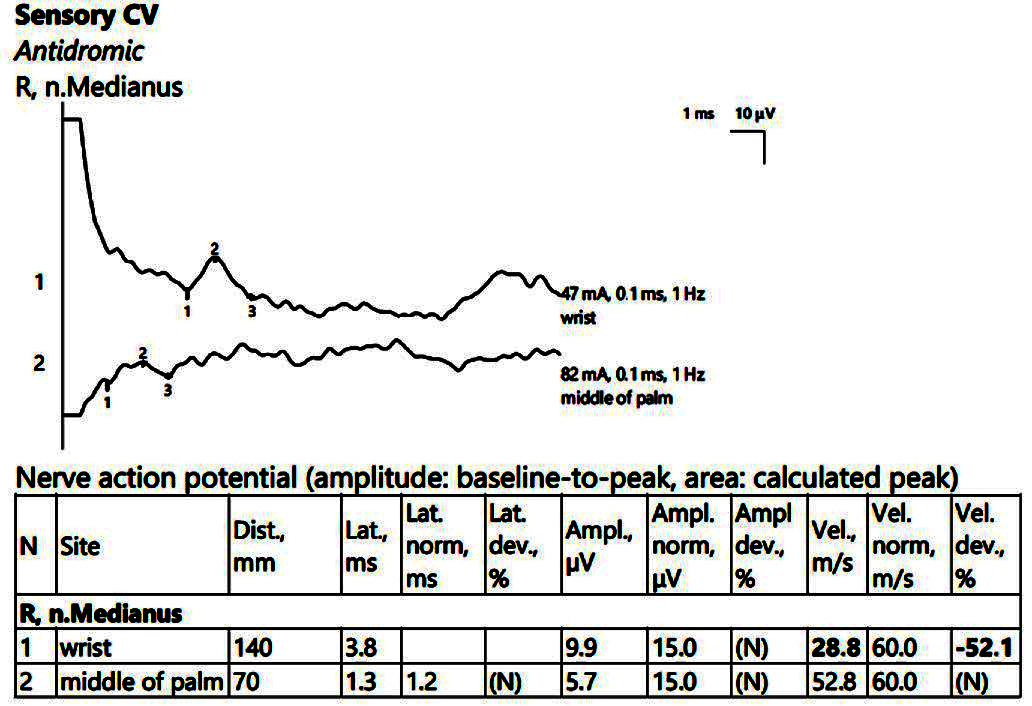

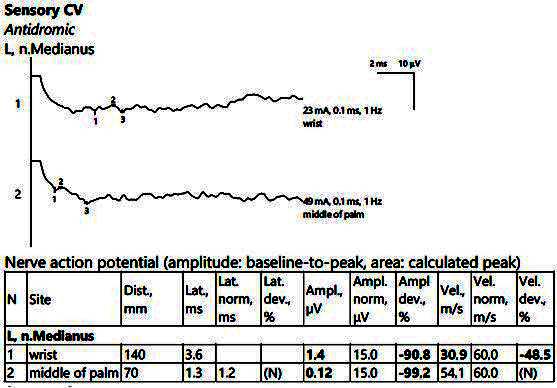

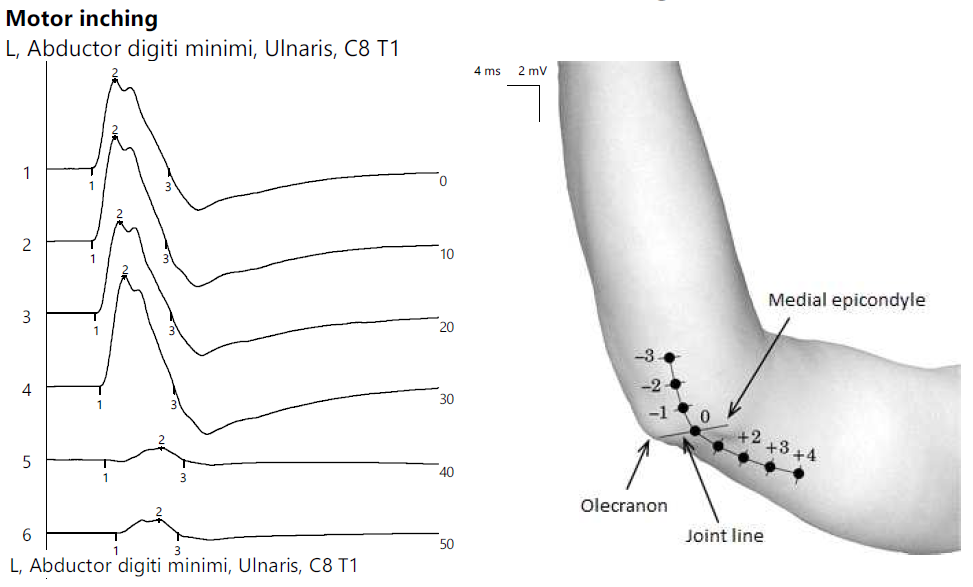
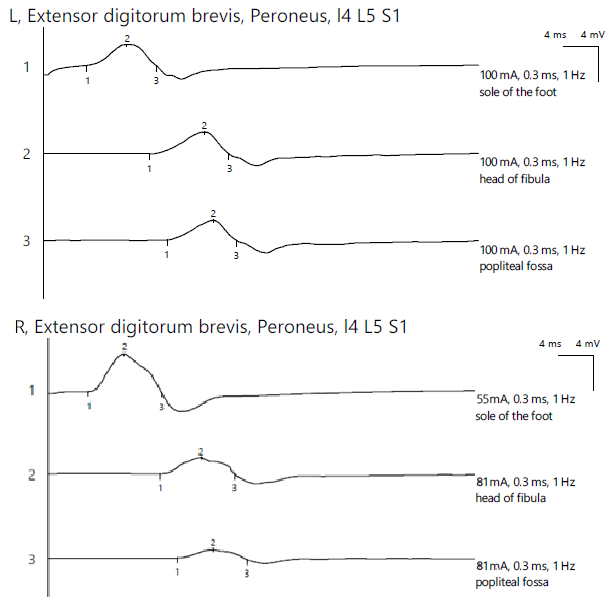
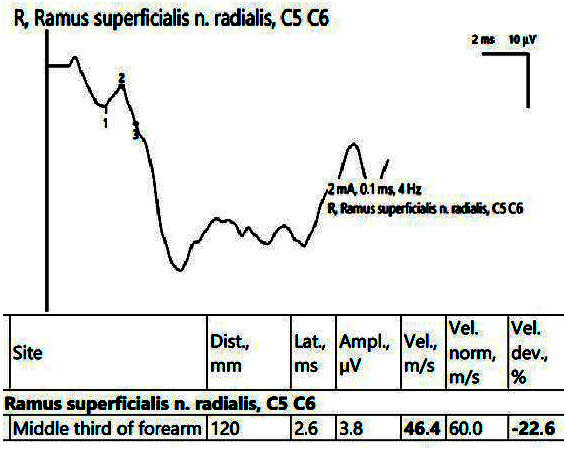



| Nerve | Onset Latency (ms) | Amplitude (mV) | Nerve Conduction Velocity (m/s) | F Wave Latency (ms) |
|---|---|---|---|---|
| Median | <4.2 | >4.4 | >49 | <31 |
| Ulnar | <3.4 | >7 | >49 | <32 |
| Radial | <5.2 | >4 | >50 | - |
| Peroneal (ankle site) | <5.8 | >2.0 | >45 | <58 |
| Tibial | <6.5 | >3.0 | >45 | <59 |
| Nerve | Onset Latency (ms) | Peak Latency (ms) | Amplitude (µV) | Nerve Conduction Velocity (m/s) |
|---|---|---|---|---|
| Median | <2.5 | <3.5 | >20 | >52 |
| Ulnar | <2.1 | <3 | >15 | >52 |
| Radial superficial | <1.9 | <2.8 | >20 | >48 |
| Sural | <4 | <4.4 | >6 | >42 |
| Peroneal superficial | <3.4 | <3.8 | >15 | >42 |
| Patient | Current HbA1c Levels (%) | SAF (AU) |
|---|---|---|
| 1 | 7.4 | 2.97 |
| 2 | 6.8 | 3.3 |
| 3 | 6.4 | 2.8 |
| 4 | 6.3 | 2.6 |
| 5 | 7.1 | 2.7 |
| 6 | 6.9 | 2.5 |
| 7 | 7.7 | 3.4 |
Disclaimer/Publisher’s Note: The statements, opinions and data contained in all publications are solely those of the individual author(s) and contributor(s) and not of MDPI and/or the editor(s). MDPI and/or the editor(s) disclaim responsibility for any injury to people or property resulting from any ideas, methods, instructions or products referred to in the content. |
© 2024 by the authors. Licensee MDPI, Basel, Switzerland. This article is an open access article distributed under the terms and conditions of the Creative Commons Attribution (CC BY) license (https://creativecommons.org/licenses/by/4.0/).
Share and Cite
Trofin, D.; Salmen, B.-M.; Salmen, T.; Trofin, D.M.; Reurean-Pintilei, D. Advancing the Diagnosis of Diabetic Neuropathies: Electrodiagnostic and Skin Autofluorescence Methods. J. Pers. Med. 2024, 14, 884. https://doi.org/10.3390/jpm14080884
Trofin D, Salmen B-M, Salmen T, Trofin DM, Reurean-Pintilei D. Advancing the Diagnosis of Diabetic Neuropathies: Electrodiagnostic and Skin Autofluorescence Methods. Journal of Personalized Medicine. 2024; 14(8):884. https://doi.org/10.3390/jpm14080884
Chicago/Turabian StyleTrofin, Dan, Bianca-Margareta Salmen, Teodor Salmen, Daniela Marilena Trofin, and Delia Reurean-Pintilei. 2024. "Advancing the Diagnosis of Diabetic Neuropathies: Electrodiagnostic and Skin Autofluorescence Methods" Journal of Personalized Medicine 14, no. 8: 884. https://doi.org/10.3390/jpm14080884
APA StyleTrofin, D., Salmen, B.-M., Salmen, T., Trofin, D. M., & Reurean-Pintilei, D. (2024). Advancing the Diagnosis of Diabetic Neuropathies: Electrodiagnostic and Skin Autofluorescence Methods. Journal of Personalized Medicine, 14(8), 884. https://doi.org/10.3390/jpm14080884








